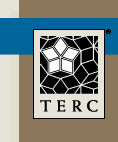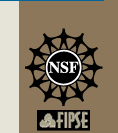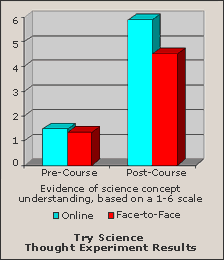 |
|
 |
|

|

Reopening the Science Door:
Lesley/TERC Online Master's in Science Education Program
NSF Teacher Enhancement Grant ESI-9911770
Summer 2002 Interim Report
Introduction
An applied research study, conducted by Dr. Wynne Harlen, parallels our development efforts. The research was designed to study and describe the learning processes and products of the Try Science course when delivered online compared with the same course taught face-to-face.
In order to collect relevant data, a 13-week three-hour on-campus course was conducted in the fall of 2001, using the same content but otherwise run as a regular face-to-face course, with 18 participants. Data from this course were compared with data collected from participants in the online Try Science course that took place in spring 2001 with 15 participants. Where possible the same data collection tools were used, with class observation and session video analysis performed in lieu of reading online postings.
Mitigating Factors
The preliminary findings of this report must be considered in the context of inherent differences between the face-to-face and online course:
- differences between course media (e.g., the potential greater flexibility
and synchronous learning in the face-to-face course vs. the pre-structured
and asynchronous learning design of the online course);
- differences arising from variables that could not be controlled (e.g.,
the online course was team taught by two instructors, whereas the on-campus
course was taught by one instructor -- a different person from the two
who team taught online); and
- differences in the backgrounds of the course participants (no attempt was made to match or randomly assign participants to courses).
The Data Gathering Process
After gathering the first data set from the online and on-campus courses, an opportunity arose to observe a course taught online by the same person who instructed the previously-documented on-campus course. Data gathered from this online offering of Try Science spring 2002 are in the process of being analyzed.
Data were collected for both course formats about:
- the learning processes (time spent, nature of interactions, reflection, etc.);
- learning outcomes (understanding of the science, of inquiry, etc., and participants' perceptions of learning); and
- the instructors' experience.
Embedded assessment was used where possible and pre- and post-questionnaires were administered and participants and instructors interviewed at the end of the course.
Preliminary Findings
The following are examples, only, of the findings from data collected for the 2001 courses:
- In relation to time spent on the course overall, online participants
consistently spent more time per week on their studies than on-campus
participants.
There was a considerable variation among online participants in regard on the time spent, far greater than the variation among face-to-face participants who spent between one and two hours per week on the course in addition to the 3 hours of the weekly meeting.
- When the findings from analysis of the online postings were compared
with the data from class observation (including video-taping of 3 entire
sessions) the main differences were in respect of categories relating
to reflection -- indicating that online participants on-line participants
refected more on the learning process on their own.
- In both courses participants responded frequently to each others'
ideas, but the online participants made more explicit reference recognizing
the value of collaborative learning.
There was as much incidence of social interaction or comments among online as on-campus participants and many online participants commented on the support they had had from fellow course members. It should be noted that the course was designed to implement a social constructivist approach to learning and this was clearly experienced. For example a participant commented that "I got insight from looking at others' (postings) and incorporated ideas into my journal. I couldn't imagine doing this course as an individual."

- Pre and post-course measures of understanding of the science content
took the form of responding to a "thought experiment"' that
was part of the course. The results showed no significant difference
between the two groups pre-course but a large and statistically significant
difference in favor of the online course post-course (see chart).
- In relation to confidence in teaching students to use and develop
various inquiry skills, there was no difference pre-course, but a significant
difference post-course in favor of the online course.
- In their lesson plans, developed and taught as part of the course, there was no difference overall between the groups in respect of including aspects relating to implementing an inquiry approach to teaching and learning. It was evident that, for all participants, a greater amount of time was needed for change to take place in their established classroom practices.
What has emerged overall so far appears to suggest that teachers can develop their understanding of science, of learning in science, and of teaching through inquiry through the Try Science course.
We would not wish to generalize to other online courses since Try Science was carefully constructed as an online course, not converted from an on-campus course. Try Science also has built-in features designed to:
- provide participants with first-hand experience with science inquiry,
- encourage collaborative learning, and
- foster reflection.
The role of the instructor/facilitator in these processes is central, albeit low-key, in encouraging peer-to-peer discussion and collective sense-making.